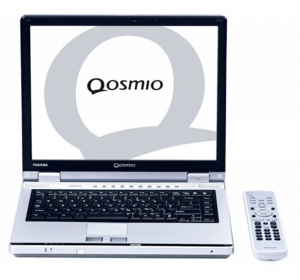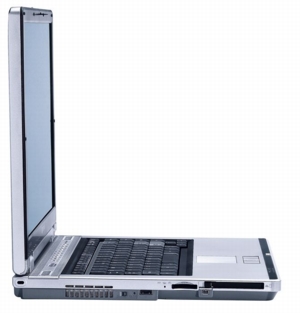 |
| About Alan |
| Tutorials |
| Free files |
| Win9x FAQs |
| E-mail Alan |
| |
| Articles |
| BIV articles |
| Archive |
| Other articles |
| Archive |
| |
 |
|
|
|
Toshiba’s Qosmio Multimedia Notebooks: Bright and Beautiful Just Don’t Expect Much Battery Life! by Alan Zisman (c) 2005 First published in Performance PC Canada February 2005 At a time when IBM has sold its well-known Thinkpad notebook line to the China's Lenovo, Toshiba has chosen to debut a new high-end line of notebooks. With its Satellite, Portege, and Tecra lines already among Canada's best-selling consumer notebooks, the company is aiming its new Qosmio (pronounced Cosmio) models at users wanting a full range of audio-visual functions in a (more or less) portable computer.  Currently,
there are two Qosmio models available. The F10-GP1 is built around a
15.4” widescreen LCD panel, and comes standard with 512MB
memory
and an 80 GB hard drive, with prices starting at $3000. Starting at
$3600, the G10-GP2 ups the ante with a 17” display, 1GB of
RAM,
and a 100 GB hard drive (actually two hard drives—a 60GB and
a
40GB unit). Both models include an 8x DVD burner, an array of audio and
video inputs and outputs, an Intel Pentium-M 745 (Centrino) processor
(running at 1.8 GHz, though Intel is downplaying clock speeds in these
CPUs), an NVidia GeForce Go 5700 graphics processor (with 128MB of
video memory), and Windows XP Media Centre 2005. A remote control is
included for use with the Media Centre software. Currently,
there are two Qosmio models available. The F10-GP1 is built around a
15.4” widescreen LCD panel, and comes standard with 512MB
memory
and an 80 GB hard drive, with prices starting at $3000. Starting at
$3600, the G10-GP2 ups the ante with a 17” display, 1GB of
RAM,
and a 100 GB hard drive (actually two hard drives—a 60GB and
a
40GB unit). Both models include an 8x DVD burner, an array of audio and
video inputs and outputs, an Intel Pentium-M 745 (Centrino) processor
(running at 1.8 GHz, though Intel is downplaying clock speeds in these
CPUs), an NVidia GeForce Go 5700 graphics processor (with 128MB of
video memory), and Windows XP Media Centre 2005. A remote control is
included for use with the Media Centre software.This unit also comes with 802.11g wireless networking built-in, and Harmon Kardon stereo speakers, providing better sound than is typical on notebook systems. One Firewire port (which Toshiba, like Sony refers to as iLink) and four USB 2.0 ports allow for connection of high-speed devices. A nice touch—the USB ports are distributed on both sides and the back of the case, making one always handy. There's no built-in floppy drive, only the option of an external USB unit, but there is a three-in-one flash memory card drive supporting Memory Stick, xD, and MMC/Secure Digital formats. Memory can be upgraded to a maximum of 2GB, and a second hard drive can be installed internally. The stand-out feature of both of the Qosmios is the video display. Toshiba boasts of its TruBrite hardware technology along with QosmioEngine software, claiming the combination produces plasma TV quality pictures. Certainly, the display is noticeably brighter and clearer than typical notebook displays, and is viewable from a wider angle.  When
viewing DVDs, picture quality is stunning, certainly the best I've seen
on a portable computer. A TV tuner is built-in, making it possible to
connect (via a too easily-lost adapter) to a standard TV cable
connection, VCR, or other device. TV picture quality is not as crisp as
DVD playback quality, though that's not Toshiba's fault. With a TV
connection and the bundled software, you can watch live TV or use the
Qosmio as a personal video recorder (PVR), scheduling recordings for
storage on the hard drive or for burning to DVD. When
viewing DVDs, picture quality is stunning, certainly the best I've seen
on a portable computer. A TV tuner is built-in, making it possible to
connect (via a too easily-lost adapter) to a standard TV cable
connection, VCR, or other device. TV picture quality is not as crisp as
DVD playback quality, though that's not Toshiba's fault. With a TV
connection and the bundled software, you can watch live TV or use the
Qosmio as a personal video recorder (PVR), scheduling recordings for
storage on the hard drive or for burning to DVD.Another nice feature (also found on HP's Pavillion dv1000 and the Averatec 6200)—you can watch TV or play a DVD movie or audio CDs without having to first boot to Windows, though you lose some of the abilities to set display quality that are available from the QosmioEngine software. With its full set of multimedia inputs and outputs, you can connect the Qosmio to display the output of a camcorder or game system, or to send your computer image to a TV. Dedicated keyboard buttons make fast work of these and other multimedia connections. The downsides? These are heavy units; designed as desktop replacements, you won't want to haul them around when you don't have to. The top of the line 17” model weighs in at 4.4 kg (9.7 lbs) while the 15” model is only a bit lighter at 3.9 kg (8.6 lbs). And while you might want to use the stunning screen to watch movies on a cross-Canada flight, you'll find the screen reduces brightness when running on battery power, but still only gets a couple of hours of life on a full charge. Toshiba advertises a paltry 1-1.6hours of battery life for the 17” model and slightly more for the 15” model. (Tip: if you're not using the integrated wireless networking, flip the handy switch to turn it off to help save on battery life; just remember to turn it back on when you do want a wireless connection). And don't look to Toshiba to provide a lot of bundled software. You'll get the standard Windows Media Player package, and some nice Toshiba utilities to simplify WiFi setup, power management, and other Control Panel options. Norton AntiVirus is pre-installed (with a 90-day subscription), as is Microsoft's nice (and not well-known) OneNote note-taking software. But don't expect to type a letter without installing additional software, unless you're a fan of Windows WordPad. There are other multimedia notebooks available, (including HP's Pavillion dv1000, the Acer Aspire 2020, and Sony's VAIO VGN-A-190, with doubtless other models coming from the competition) but if you've got the cash, Qosmio's superb screen, TV tuner and PVR functions, and wealth of input and output connections make this the one to get. |
|
|
|
|
| Alan Zisman is a Vancouver educator, writer, and computer specialist. He can be reached at E-mail Alan |
